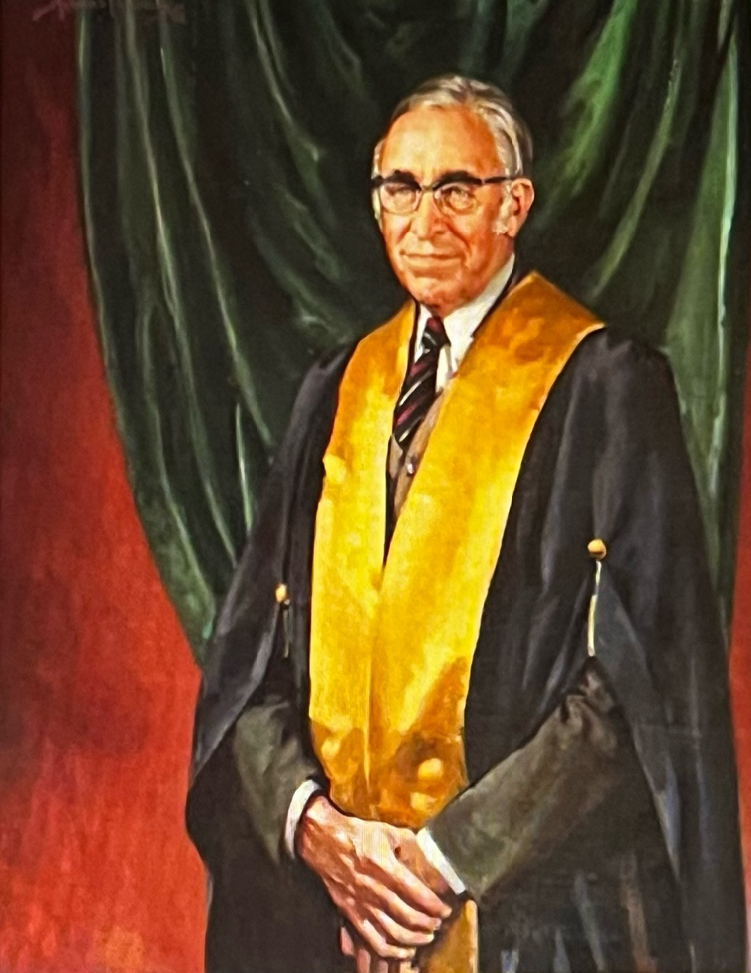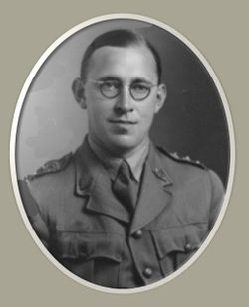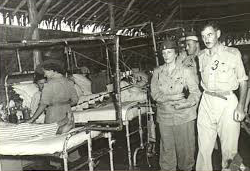
Portrait: Artist by Harold Freedman (1982) Presented to the Victorian Branch Australian Medical Association by the Victorian Medical Insurance Agency Ltd.
Dr Geoffrey Newman-Morris Kt 1969 KStJ 1964 ED1946 MBBS 1937 MS 1936 MRCS and FRCS 1937 FRACS 1938 A BMA/AMA Member 1933-1981 – a medical doctor, a military hero and a humanitarian:
He was born on the 14th of May 1909 in Violet Town, a small town in rural Victoria. His father was the town’s resident medical doctor and his mother a nurse. In 1911 the family moved to Hawthorn, a suburb in Melbourne.
He attended Camberwell Grammar, Grimwade House and Senior School of Melbourne Church of England Grammar School. Initially he did not plan to be a doctor. He is quoted as saying he aimed for a “classical education” learning Latin and Greek. His future direction changed in his last two years of school. He entered Trinity College at the University of Melbourne in 1927 to study Medicine graduating with MBBS in 1932.
For nine years at the Old Melbourne Hospital, he worked as a medical student, a resident medical officer and a surgical trainee. He was the Beaney Scholar in Pathology and obtained his Master of Surgery in 1936. The following year he travelled to England to study and obtained his Fellowship of the Royal College of Surgeons. On returning to Australia in 1938, he gained his Fellowship of the Royal Australian College of Surgeons.
His military commitment started in the Melbourne Grammar School Cadets, then in 1927 the Melbourne University Rifles. In 1933 he was commissioned in the Citizens Military Force where he rose to the rank of Temporary Major. The 2nd Field Ambulance in the Militia was commanded by Colonel William Wallace Stewart Johnston, a medical practitioner and notable military man who was the recipient of the Military Cross, Distinguished Service Order and Mentioned in Despatches. Both knew each other through School, Medicine, Trinity College and Saint John Ambulance and the Australian Red Cross Society Organisations. Their lives were intertwined with similar life directions and interests.
In later years both were knighted for their extensive commitments to their professions and the community.
In 1939 Australia entered War World Two, Geoffrey Newman Morris continued with the 3rd Cavalry Field company. Early in 1940 was posted to the Sea Ambulance Transport Company travelling on troop ships as the Medical Officer caring for Australian and New Zealand servicemen travelling to the War in Europe and those invalided and returning to Australia. On return to Australia, he was taken on strength in the Australia Army Medical Corps of the 2/7 AGH of the Australia Imperial Force.
He served at the Army Hospital at Puckapunyal Victoria then posted overseas to the Middle East where he saw service with the 2/7th and the 2/11th Australian General Hospitals, in Alexandria in Egypt and Palestine. In 1943 he went to Papua New Guinea landing at Buna Bay in the Buna Campaign. He was promoted to Lieutenant Colonel in 1943 and sent to 2/7 AGH in Lae.
In the latter part of the War, he returned to Australia to serve as Commanding Officer of the Surgical Unit at 106 AGH at Bonegilla, near Wodonga in Victoria. 106 Hospital Bonegilla became a rehabilitation centre with emphasis of treating soldiers suffering malaria and tuberculosis.
He was Mentioned in Despatches for his war service in Papua New Guinea and awarded the Efficiency Decoration in 1946 for more than 20 years of meritorious, continuous service in the military.
In 1946, after discharge from the AIF, he returned to civilian medical practice in 14 Collins Street Melbourne Victoria.
 He was the Honorary Surgeon at the now demolished Prince Henry’s Hospital in St Kilda Road, Melbourne both in Outpatients from 1946-1950 and Inpatients from 1950 until his retirement in 1986. He became the Chairman of the Honorary Medical Staff and an Honorary Life Governor of the Hospital. With Professor Hugh Dudley CBE MB ChM FRCS (Ed) FRACS, he was involved in the future planning of surgical services in the merger with Queen Victoria Medical Centre to form the new hospital called Monash Medical Centre at Clayton, Melbourne. The planning involved travelling overseas to compare and learn from other contemporary” best practice” facilities.
He was the Honorary Surgeon at the now demolished Prince Henry’s Hospital in St Kilda Road, Melbourne both in Outpatients from 1946-1950 and Inpatients from 1950 until his retirement in 1986. He became the Chairman of the Honorary Medical Staff and an Honorary Life Governor of the Hospital. With Professor Hugh Dudley CBE MB ChM FRCS (Ed) FRACS, he was involved in the future planning of surgical services in the merger with Queen Victoria Medical Centre to form the new hospital called Monash Medical Centre at Clayton, Melbourne. The planning involved travelling overseas to compare and learn from other contemporary” best practice” facilities.
He lectured and examined students in both Melbourne and Monash medical schools. From 1959 to 1967 he was on the Victorian State Committee of the Royal Australian College of Surgeons ensuring a high standard for future surgeons. His interest in medical education extended to Nurses, being the Chairman of the Board of examiners of the Nursing Board of Victoria and a member of the Council of the Royal Victorian of Nursing.
In 1956, he was appointed as Medical Officer to the Victorian Police and was influential in the development of the Police Hospital on the corner of St Kilda Road and Southbank Boulevard. It was a unique facility for the Victoria Police, possibly being one of few Police Forces in the world having its own private hospital. For his commitment he was made an Honorary Life Member of the Police Association. The hospital was closed in 1981, and the building renovated and is now part of the University of Melbourne Arts Department and Victoria College of the Arts.
He was elected to the Council of the British Medical Association Victorian Branch in 1953 and filled the offices of Branch Honorary Secretary (1955-57), Vice President President (1959-1960) and President (1961).
In 1962, BMA State branches formally merged into the Australian Medical Association, and he was elected Chairman of the Victorian Council from 1965-1973. Representing the profession, he attended the World Medical Congress in New York USA in 1973 as the Australian Delegate. He was on the AMA Federal Assembly (1967-1972). In the following year in Melbourne, as the President of the 5th Australian Medical Congress he was awarded the highest honour of the AMA, the Gold Medal.
His involvement with other medical associations was vast and world-wide. He was President of the Confederation of Medical Associations of Asia and Oceania 1975 (its objectives “to promote academic exchange and cultivate ties of friendship between member medical associations”).
Later in life he retired as a surgeon; He continued working as a medicolegal consultant. He was the President of the Medico-Legal Society of Victoria in 1968.
Dr Newman -Morris was a leader in both St John Ambulance and the Australian Red Cross Society.
He had been a lecturer with St John Ambulance since 1933, a member of St John Council 1950-1963, and Vice President from 1964-1976. He joined the Brigade on the 1 January 1953 as the Divisional Surgeon of the Railways Division following Dr Douglas Donald MBBS (Melbourne) FRCS (Eng), when his colleague Sir William Wallace Stewart Johnston MB et ChB MD(Melbourne) was the Commissioner. He transferred to the Melbourne Division in 1957 being promoted to Victoria District Staff in 1960, District Surgeon 1962, Deputy Commissioner in 1962 to Commissioner Douglas Donald. He became the Victorian Commissioner in 1966. In 1969, he was promoted to the Australian Headquarters Staff as Chief Surgeon. He was invested as a Knight of St John in 1964.
 In the early 1950’s, he commenced an association with the Australian Red Cross Society: firstly, as a member of the Australian Red Cross Welfare Committee, then the Council of the Victorian Division, and the following year he was appointed to the National Executive. He was Chairman of the Australian Red Cross Society National Council for 20 years from 1958 to1978.
In the early 1950’s, he commenced an association with the Australian Red Cross Society: firstly, as a member of the Australian Red Cross Welfare Committee, then the Council of the Victorian Division, and the following year he was appointed to the National Executive. He was Chairman of the Australian Red Cross Society National Council for 20 years from 1958 to1978.
Sir Geoffrey Newman -Morris served with the International Red Cross community. In 1965 he attended the International Conference of the Red Cross in Vienna and was elected as a member of the Standing Committee of the International Red Cross. In 1973 he became its Chairman, a role he held until 1978. He attended many International Conferences: as a member of Australian Delegations and in his capacity as President. He was Vice Chairman of the League of the Red Cross Society 1969-1973; Chairman of the Finance Committee 1967-77.
In 1979 he was awarded by the International Red Cross as a tribute to his service, its highest honour, the Henry Dunant Medal.
Sir Geoffrey Newman-Morris died, aged 72, in Melbourne in October 1981.
He was admired and praised as a distinguished surgeon and a fine arbitrator, an administrator and a compassionate human being.
This biography has been prepared by Dr Jean Douglas. Data has been obtained from AMA Victoria, Medical Journal of Australia, Australian War Memorial, University of Melbourne Archives, National Archives of Australia, Red Cross Society and St John Ambulance websites and Dr Allan Mawdsley OAM.
